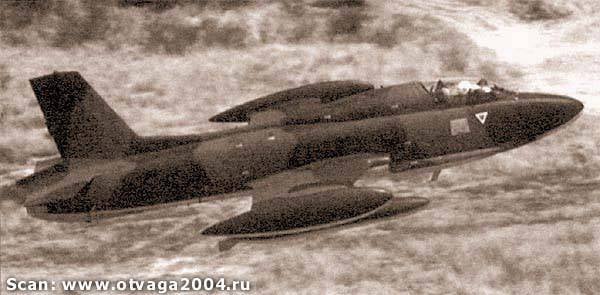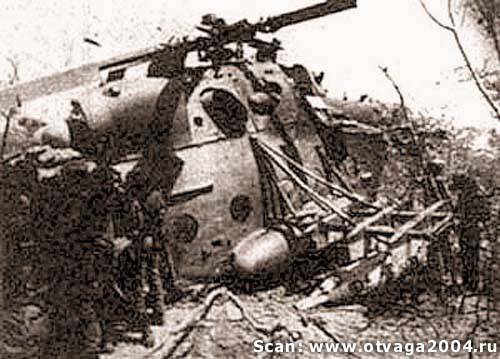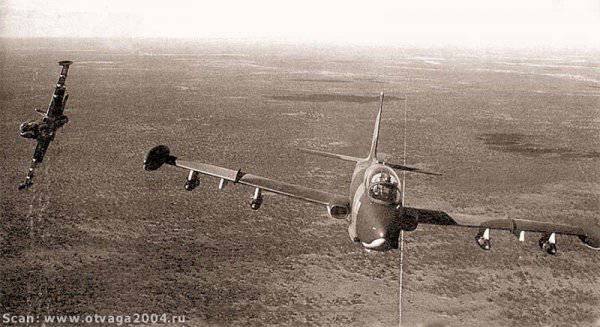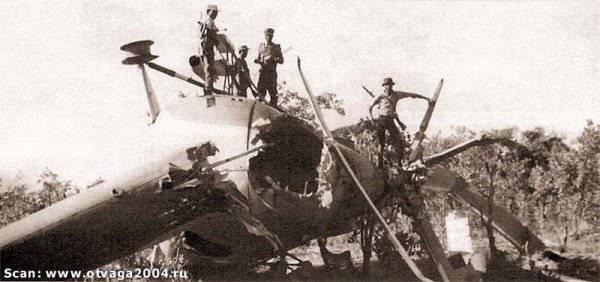Hunting for the "Crocodile"
In the autumn of 1985, the Angolan army (FAPLA) and Cuban units that fought on its side carried out an operation known in the West as the “Second Congress”. The aim of the operation was to restore government control over the province of Kuzombo and defeat UNITA insurgent groups in the area of the “capital” of the rebels - the city of Jamba.
Aviation support was provided by the Angola Air Force squadrons based at the Menong and Quito Kwanavale airfields. In Menong, aircraft were located, in Quito - helicopters: four Mi-25 (export version of Mi-24), two Mi-8 and four Mi-17. The combat “crocodiles” were entrusted with the tasks of escorting transport helicopters, “clearing” the sites before landing and providing direct air support.
When accompanied by "eights" Mi-25 helicopters flew at a height of about 900 - 1800 m, keeping a little higher and away from transport vehicles. Sometimes, the "turntables" were accompanied by Cuban-controlled MiG-23 fighters, circling at altitudes 4000 - 5000 m.
The offensive of the government troops was developing successfully: by October, the rebel leader Savimbi was in a very difficult situation - the government troops reached the near approaches to Jamba. UNITA help has once again come from South Africa. Impala airplanes of the South African Air Force were deployed at the Randu airbase. By joint actions of South Africans and Savimbi detachments, FAPLA’s attack in late October was stopped. However, intelligence reported that Angolan troops were preparing a new operation, with helicopters providing quick maneuver to government troops.

Savimbi personally appealed to his South African allies with a proposal to use the Impala attack aircraft to fight helicopters. The first reaction to this idea was bewilderment. First, no one has ever applied or even developed the tactics of air combat against helicopters in Africa. Secondly, there were fears that the growing use of South African air forces would lead to an escalation of the conflict, in particular, to the retaliatory strikes of Angolan MiGs on air bases in South Africa itself.
After much hesitation, the decision to use the aircraft against the Angolan helicopters, in the first place - the Mi-25, was still made.
South African intelligence has established extremely low professional skills of crocodile crews. The Angolan pilots had a bad navigator training, because of which the flight routes were laid only along the visible natural landmarks - rivers or roads. In bad weather, the helicopters did not fly, there was no discipline in the radio communications of the crews.
All this, of course, facilitated the task of the Impalam, but after all, the South African pilots did not have the slightest experience in conducting air battles, and even more so with helicopters, they were taught only to strike at ground targets.
After deciding to fight helicopters, Pretoria immediately organized a series of flight tests to develop the best tactics for Mi-25 attacks by jet aircraft. The Puma helicopters imitated the typical flight profiles of the Angolan “choppers” (chopper - “woodcutter” - the western nickname Mi-25).
The problem was complicated by the presence of a serious threat to the Impalam from the MiG-23. MiGs, as already mentioned, were piloted by Cubans, whose training, at least, was not inferior to the training of South African pilots, and with the equal skill of pilots, the Impal had no chances in air combat with MiGs; in the end, the Impala is just a modification of the Italian training plane MB.326K.
South Africans could only hope for a sudden short-term attack, for which they needed to go out to the battlefield at the height of the tops of the trees in order not to get on the screens of the Angolan radar.
Attacking helicopters should be carried out from the rear hemisphere with a slight excess in height, however, it was not all simple. First of all, this is the traditional tactic of air combat that the Angolan helicopter pilots somehow knew. Therefore, Mi-25 did not rule out attacks from the tail and periodically turned, checking for the presence of an enemy in the rear hemisphere. Secondly, the speed of the Impala, even hung with outboard arms, is much higher than the speed of a helicopter, that is, when an unsuccessful attack occurred, the plane jumped forward, putting its tail under the fire of a powerful weapons "Crocodile".
In the end, the best attack was recognized by a pair at a minimum speed close to the stall mode. At the same time, the aircraft also carried out “scissors”, trying to at least somehow equalize their speed with the speed of helicopters. The first to lead the helicopter was to open fire leading pair, and the share of the slave remained the leading Mi-25. Fortunately for South Africans, they did not have to go in for “free hunting” - the routes and even the time of flight of the helicopters were well known and did not change over the course of weeks. The zone of the upcoming battles was located in 35 minutes of the Impal flight from the Randu airfield, and only a few minutes were allotted for the fight.
Four pairs of airplanes were allocated for interception, three of them were percussions, and one was “insured.” In the event of an unfavorable development of events, she was supposed to cover the downed pilot before the arrival of two search and rescue helicopters Puma. The entire flight was to be performed in radio silence mode. The pilots were forbidden to be distracted by any other purpose, except for helicopters, even if the meeting with the Mi-25 for some reason did not take place. The situation on the helicopter flight route was monitored by light single-engine reconnaissance aircraft, which were based at the airfield of jumping. The command to take off "Impal" was given only after the detection of the enemy.
On the evening of September 27, the code word “Bravo” was sounded in the flight room of the Randa airfield from the loudspeaker 1985. Helicopters were found. A pair of Mi-25 took off from the air base Kvito-Kvanavale. Four pairs of airplanes took off at an interval of four minutes and headed north.
The first to establish visual contact with the helicopters was the lead of the second pair, the Impal. Mi-25 went at a height of about 600 m. The pilot freely took the starting position to attack from behind from above. The attack went off like an exercise - a line of Impala-driven 20 mm guns pierced the Mi-25 fuselage from the tail rotor to the nose turret. The helicopter broke out, but the pilot continued to operate the machine, hoping to land safely. Then Impala turned around and attacked a second time, firing unguided rockets from the underwing blocks.

The host pursued another Mi-25. The pilot of the second helicopter turned on the 180 ° and began to dive off to the ground. "Impala" went on the attack with an overload of 5G and from a rather unsuccessful angle from the bottom side. The pilot opened fire from a cannon at a distance of approximately 500 m. As the aiming point, he chose the exhaust nozzle of the helicopter APU. According to the pilot report, nineteen shells hit the helicopter's fuselage, approximately opposite the main gearbox. South African could not resist the opportunity to admire the results of their work. At extremely low speed, he passed over the Mi-25, watching the agony of the downed car. From the helicopter flew off the panel of the engine cowls, then - the rotor blades, then the "crocodile" fell on the tail and, randomly tumbling, fell to the ground.
Led meanwhile also celebrated the victory. In the next approach, he finished off the Mi-25 from a cannon; the helicopter also flew in different directions of the main rotor blades, the car crashed into the ground and exploded.
South African aircraft at extremely low altitude, fearing a meeting with MiGs, rushed to their base. The first "hunt" was successfully completed.
Two days later, on September 29, at 9, the Bravo signal sounded again at the Randu airfield at 8. This time, a pair of Mi-25s flew up with Quito-Kvanavale, guarded by two Mi-900s. The Impalas took off. It was not necessary to search for the enemy for a long time - helicopters followed at an altitude of XNUMX meters, repeating the bends of the Lomba River. "Eight" flew front of the system, about a kilometer behind them, one after another, "crocodiles".
South Africans did not reinvent the wheel: the lead pair attacked the locking Mi-25 from the rear hemisphere with an elevation of 300 meters. A long line of guns went through the fuselage of the helicopter, the Mi-25 caught fire, but the flight continued.
At the same time, problems arose at the Impala itself - the exit to extremely low speed and powder gases from firing disrupted the engine. Nevertheless, the pilot decided to attack the second Mi-25, but, taking up the position for a strike, he passed under the noses of a burning "crocodile", receiving a portion of the lead from the YakB four-barreled machine gun. The Angolan not only tried to keep the helicopter burning on the course, but also did not miss the chance to attack. True, the damage of the South African attack aircraft was not fatal. From a distance of 500, Impala shot the second Mi-25. The helicopter did not catch fire, but spiraled downward. When it hit the ground, it exploded.

After the destruction of the escort, the Impala attacked transport workers. Slave Mi-8 they managed to bring down, but the leader in time dived to the ground and began to wind through the trees. All attempts to get it with shells of air cannons ended in vain. The battle so far led only one pair of aircraft. Having failed to cope with the "twisted" "eight", the Yuarovsky pilots called for help from their comrades, but soon the Mi-8 disappeared from view.
In the post-flight report, the pilots "Impal" noted that the helicopter aggressively maneuvered, even trying to attack the aircraft on a collision course. The maneuvers that the pilot Mi-8 was doing indicated that he was well aware of the tactics of air combat, and the South Africans decided that it was not an African who was sitting in the cockpit, but a Russian.
The second pair, the Impal, came to the rescue and managed to re-discover the surviving helicopter, but attempts to hit it were not successful. The G8 continued to maneuver intensively, turning from time to time to imitate a frontal attack. In the end, the aircraft still forced the pilot of the Mi-8 to land and shot the helicopter after landing.
At this time, the third pair of “hunters” approached the battlefield, and the leader of the first pair spotted two MiG-23. Angolan fighters quickly swept over the battlefield at the height of the entire 10-15 meters, after which the candle at the fast and the fuse soared into the sky, taking up a position to attack. Now the Impala played the game game.
South African fighters still managed to “take away their legs” without loss.
The "Crocodile Hunt" was crowned with complete success: having lost six helicopters in two days, the Angolans refused to use the "turntables" for transporting troops and cargo. The success was accompanied by South Africans, primarily because of the suddenness of the attack. So, if in the last battle on the spot Mi-8 was Mi-24, then it is not yet known how this battle would end (the G-8 could only imitate attacks due to the lack of on-board armament).
The convincing victory of the aircraft over the helicopters did not at all put an end to the use of rotary-wing attack aircraft in the longstanding Angolan war. Already in winter 1985-86. The Mi-25 supported the advance of the FAPLA armored units in the Mawingi and Casingi area, causing heavy losses in the UNITA units.


Information